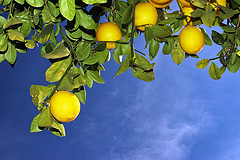Lemons
| Infobox on Lemons | |
|---|---|
| Example of Lemons |  |
| Freshness facts | |
| Optimum carrying temperature | 10°C to 11°C (yellow lemons) 12°C to 14°C (green lemons) |
| Highest freezing point | -1,4°C |
| Acceptable product temp. at loading into containers | Max. 5°C above carrying temperature |
| Optimum humidity | 90% |
| Ventilation setting for containers | 25 m³/hr |
| Storage life | 2-3 months |
| Climacteric / non-climacteric | Non-climacteric |
| Ethylene production | Very Low |
| Ethylene sensitivity | Moderate |
| Modified / controlled atmosphere | 0%-10% CO2; 5%-10% O2 |
| Potential benefits | Low O2 delays senescence. Elevated CO2 may delay loss of green colour |
| Availability | |
| South Africa South America |
May - December June - November |
Lemons
Contents
Harvesting and handling
The degree of ripeness of citrus fruit is determined on the basis of three criteria:
by the ripeness index:
this is determined by the Brix value, which is a measure of the sugar/acid ratio of the fruit. Citrus fruit with a Brix value of between 10 and 16 have good flavour;
by cutting at purchase:
freshness is determined by cutting the fruit in half from the stem-end to the opposite end. If the fruit is withered at the stem-end, it must not be shipped;
by peel colour:
the colour of the peel is not necessarily a reliable indicator of ripeness, but its surface gloss is. Glossy lemons are ripe, even if they are still green or have green spots.
Waxing to prevent loss of aroma and weight is required because the washing process removes the natural wax layer. The film of wax sprayed onto the peel only partially seals the pores so that the fruits are still able to respire.
Because of its impact- and pressure-sensitivity, the fruit has to be handled with appropriate care.
The primary quality characteristics are intensity and uniformity of yellow colour, size, shape, smoothness, firmness, freedom from decay and defects including freezing damage, drying, mechanical damage, rind stains, red blotch, shrivelling and discolouration. Lemons should have smooth thin skins and be firm. Ripe lemons should have a pleasant citrus fragrance.
Cooling and storage
Yellow lemons harvested when dark-green have a much longer postharvest life than those picked yellow, which must be marketed more rapidly due to their shorter shelf-life.
Lemons can be stored between 10°C to 14°C depending on the maturity-ripeness stage at harvest, season of harvest, storage time and production area. They can be stored for up to 6 months under the right conditions. The cargo should be pre-cooled prior to loading.
Depending upon the species and variety, all citrus fruits are highly cold-sensitive. Grapefruit, lemons and limes are more susceptible to chilling damage than are oranges and mandarins, and late-ripening varieties are more temperature-sensitive than early varieties. While oranges can withstand temperatures of 5°C, more temperature-sensitive types should never be shipped below 10°C. Green citrus fruits require higher transport temperatures than do yellow; the higher is the acid content of the fruit, the greater is its cold-sensitivity.
Chilling damage is manifested in citrus fruits in particular by spots on the peel (brown dots on the peel), accompanied by a bitter taste and unpleasant odour, rot and cell wall collapse. The glossiness of the peel is lost and the albedo layer (inner layer of the peel), which is normally white, turns a dark colour. When the fruit is divided up, the segments, which have a low juice content, break up and the whole fruit is glassy and soft. The severity of the chilling damage is determined not only by the extent to which the temperature has fallen beneath the limit, but also by the length of exposure to this temperature. Moreover chilling severity depends upon cultivar, production area, harvest time and maturity-ripeness stage at harvest. Moderate to severe chilling injury is usually followed by decay.
Excessively rapid warming of refrigerated fruit results in condensation and spoilage.
Yellow lemons should be kept above +10°C, as lower temperatures encourage the earlier development of physiological disorders (internal browning, peel pitting), especially where the fruit is harvested early. At this temperature lemons may be kept for several months.
Temperatures higher than 15°C favour the growth of decay organisms and shorten the storage life. Lemons that are of proper size and dark-green colour when picked have the longest storage life. Tree-ripened, yellow fruit do not keep so well in storage. Lemons from different production areas have different keeping qualities.
Storage at terminal markets often involves considerable risk, as most of the storage life may have been used up before shipment and the fruit may be especially subject to decay. Therefore, knowledge of the previous history of the lemons is desirable.
Levels of respiratory gases which promote ripening, such as ethylene as well as carbon dioxide, should be kept as low as possible. If ventilation is inadequate, storage damage, such as a bitter flavour and peel scab, may occur. The supply of fresh air must thus be constant in order to dissipate these gases.
Fungicides are diphenyl, orthophenylphenol (OPP) and thiabendazole (TBZ). Diphenyl can be recognised from its naphthalene-like odour. The fungicides primarily prevent blue and green moulds, but they do impair flavour and indication of their use is mandatory.
Seawater, rain and condensation water promote green and blue mould growth.
Mixed loads
Lemons should not be mixed with ethylene-producing commodities. Lemons absorb odours from strongly scented vegetables and so should not be mixed with such commodities.
Cautions
O2 below 5% can cause off-flavours. CO2 greater than 10% may cause increased susceptibility to decay as well as decreased acidity.
Storage disorders
Alternaria rot, Anthracnose, Aspergillus rot, Black mould rot, Black pit, Black spot, Blue mould, Brown rot, Canker, Chilling injury, Cottonry rot, Degreening, Fusarium, Green mould rot, Grey mould rot, Insect damage, Melanose, Rind discolouration, Scab, Scald, Senescent breakdown, Sooty blotch, Sooty mould, Stem end rot.











